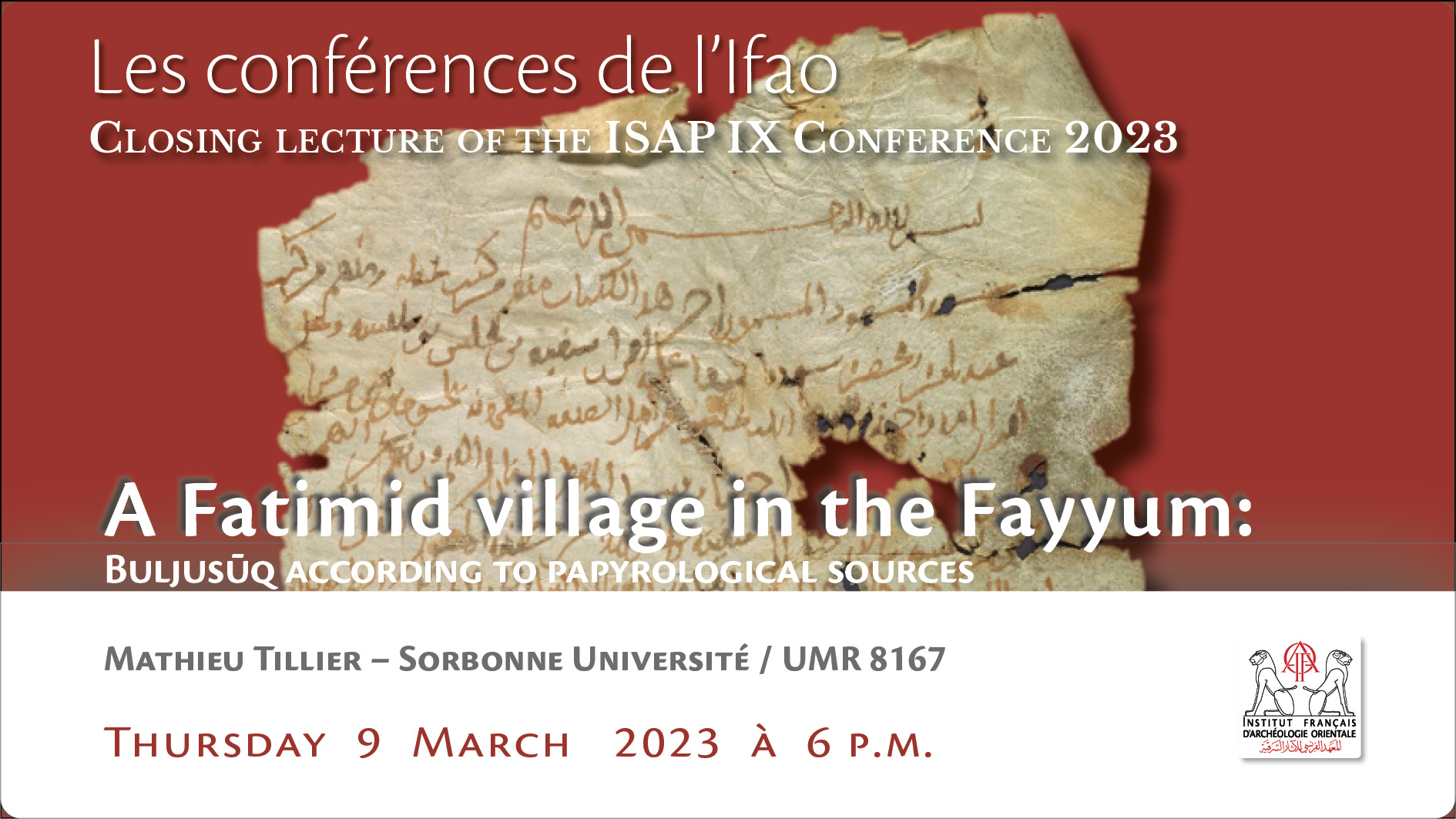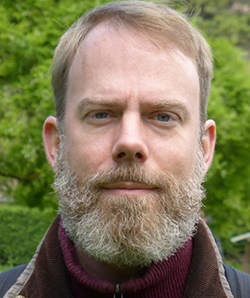Manifestations scientifiques
Abonnez-vous à la … Subscribe to the Mailing list :

Les conférences de l’Ifao
Le jeudi 9 mars 2023 à 18h00 (heure du Caire), IFAO 
A Fatimid village in the Fayyum:
Buljusūq according to papyrological sources
Mathieu Tillier
Langue : anglais.
Mathieu Tillier, Professor of History of the Medieval Muslim World at the Sorbonne University and associate researcher at the UMR 8167 Orient et Méditerranée, Medieval Islam team, will give the closing lecture of the Ninth ISAP Conference at the Ifao, Thursday 9 March at 6 p.m. The lecture will be intiteled : A Fatimid village in the Fayyum: Buljusūq according to papyrological sources.
The Ninth ISAP Conference will be hosted by the Faculty of Archaeology (Egyptology Department) of Fayoum University from 6 to 9 March 2023 and be organized by the board of the ISAP and the Munich Institute of Near and Middle Eastern Studies.
Abstract:
Thanks to the desertification of the Tanabṭawayh Canal in the second half of the eleventh century CE, the inhabitants of the southern fringe of the Fayyum were forced to move their villages northward, following the example of Ṭuṭūn, which is well known thanks to archaeological excavations. The migrants sometimes left part of their archives on site. As a result, these archives have partly survived the passage of time and now allow us to study the social, economic and institutional life of those rural settlements, especially in the early Fatimid period.
The ancient village of Buljusūq (the ancient Kerkesoucha Orous) is one of these lost villages of the southern Fayyum. It has been documented so far by 18 edited documents, and remains much less understood than Ṭuṭūn. Over the past five years, Naïm Vanthieghem and I have identified 21 new documents from this village, and their study has allowed us, among other things, to locate this village more precisely along the Tanabṭawayh village. The resulting corpus, consisting mainly of legal deeds (deeds of sale, inheritance, lease contracts, tax receipts), documents several Coptic families of the village, and enables us to propose a reconstruction of a series of neighborhoods between 335/946 and 450/1058, as well as several aspects of the village’s institutional structures and agricultural economy. At the beginning of the Fatimid period, the settlement appears to have been partially Islamized, and had a mosque, probably to the north of the central part of the village which was still populated by Christian populations.
The study of these deeds makes it possible not only to better understand the articulation between various institutions within the village, but also to reconstitute some of the land parcels. Although the village of Buljusūq has now vanished, it can be assumed that its architecture followed the pattern of other villages on the southern fringe of the Fayyum, some of which have been excavated. By confronting archaeological data available for other villages – especially Ṭuṭūn – with the information that can be gleaned from the Buljusūq documents, I will attempt to show what this village may have looked like in the first half of the eleventh century CE, and how resident Coptic families managed their land holdings, especially through succession strategies.
Résumé :
Grâce à la désertification du canal Tanabṭawayh dans la seconde moitié du XIe siècle, les habitants de la frange méridionale du Fayoum furent obligés de déplacer leurs villages vers le nord, à l’exemple de Ṭuṭūn bien connue grâce aux fouilles archéologiques qui ont pu s’y tenir. Les migrants laissèrent parfois sur place une partie de leurs archives, qui ont ainsi survécu au temps et permettent aujourd’hui d’étudier la vie sociale, économique et institutionnelle de ces territoires ruraux, en particulier au début de l’époque fatimide.
L’ancien village de Buljusūq (l’antique Kerkesoucha Orous) est l’un de ces villages disparus du Fayoum méridional. Jusqu’ici documenté par 18 documents édités, il reste beaucoup moins connu que Ṭuṭūn. Au cours des cinq dernières années, Naïm Vanthieghem et moi-même avons identifié 21 nouveaux documents issus de ce village, et leur étude a notamment permis de localiser ce village avec plus de précision. Le corpus ainsi réuni, consistant essentiellement en actes juridiques (actes de vente, de succession, contrats d’affermage, reçus de taxes), documente plusieurs familles coptes du village, et permet de proposer une reconstitution une série de quartiers de ce village entre 335/946 et 450/1058, ainsi que plusieurs aspects de ses structures institutionnelles et de son économie agricole. Au début de l’époque fatimide, il apparaît comme un bourg déjà en partie islamisé, disposant d’une mosquée vraisemblablement au nord de la partie centrale du village, encore peuplée de populations chrétiennes.
L’étude de ces actes permet non seulement de mieux comprendre l’articulation entre différentes institutions au sein du village, mais d’en restituer également une partie du parcellaire. Bien que le village de Buljusūq ait aujourd’hui disparu, on peut présumer que son architecture se conformait au modèle d’autres villages de la frange méridionale du Fayoum, dont certains ont été fouillés. En confrontant les données archéologiques disponibles pour d’autres villages – notamment Ṭuṭūn – aux informations que l’on peut glaner dans les documents de Buljusūq, je tenterai de montrer à quoi pouvait ressembler ce dernier village dans la première moitié du XIe siècle, et comment les familles coptes qui y résidaient géraient leur patrimoine foncier, notamment par le biais des successions.

Mathieu Tillier is a professor of Medieval Islamic history at Sorbonne Université and a member of the CNRS research unit “Orient et Méditerranée” (UMR 8167). He is the author of Les cadis d’Iraq et l’État abbasside (Damascus: Presses de l’Ifpo, 2009) and L’invention du cadi. La justice des musulmans, des juifs et des chrétiens aux premiers siècles de l’Islam (Paris : Publications de la Sorbonne, 2017).
En lien avec cet évènement

Les conférences de l’Ifao
Les conférences de l'Ifao ont pour objectif la transmission des résultats des recherches en cours ou très récentes, par des chercheurs confirmés. Y sont conviés essentiellement les chercheurs impliqués dans les différentes opérations scientifiques de l'Ifao lors de leur passage par l'Institut. ِElles sont également parfois le lieu de présentation d'ouvrages récemment parus à l'Ifao par leurs autheurs. Les conférences de l'Ifao ont lieu traditionnellement le mercredi à 18h, en français ou en anglais.
IFAO Lectures series aim to transmit the results of current or very recent research by confirmed researchers. They are mainly animated by researchers involved in IFAO's various scientific programs and projects during their stay at the Institute. They are also sometimes the occasion for presentations, by their authors, of books recently published by the IFAO.
IFAO Lectures series are traditionally held on Wednesdays at 6 p.m., in French or English.


